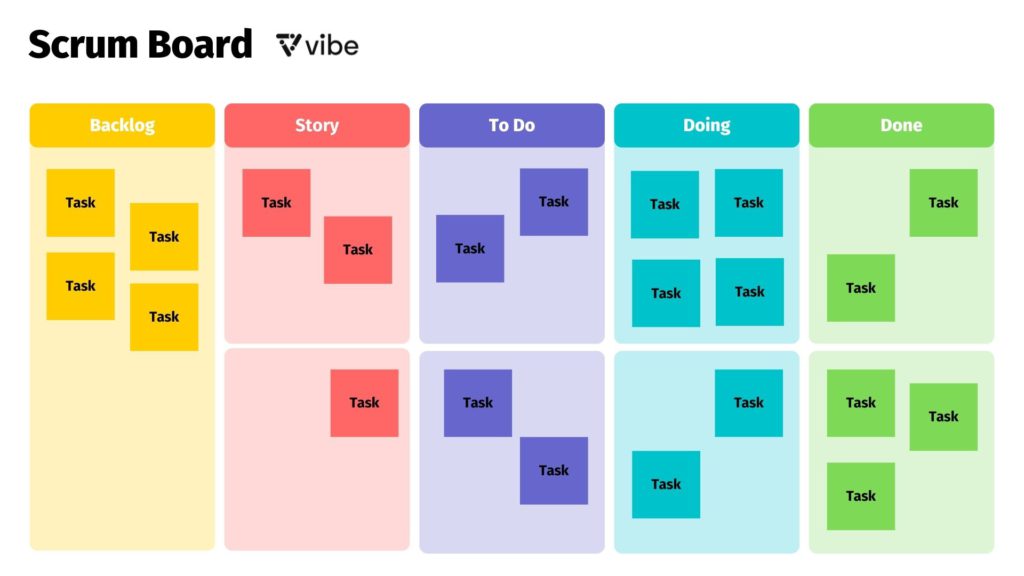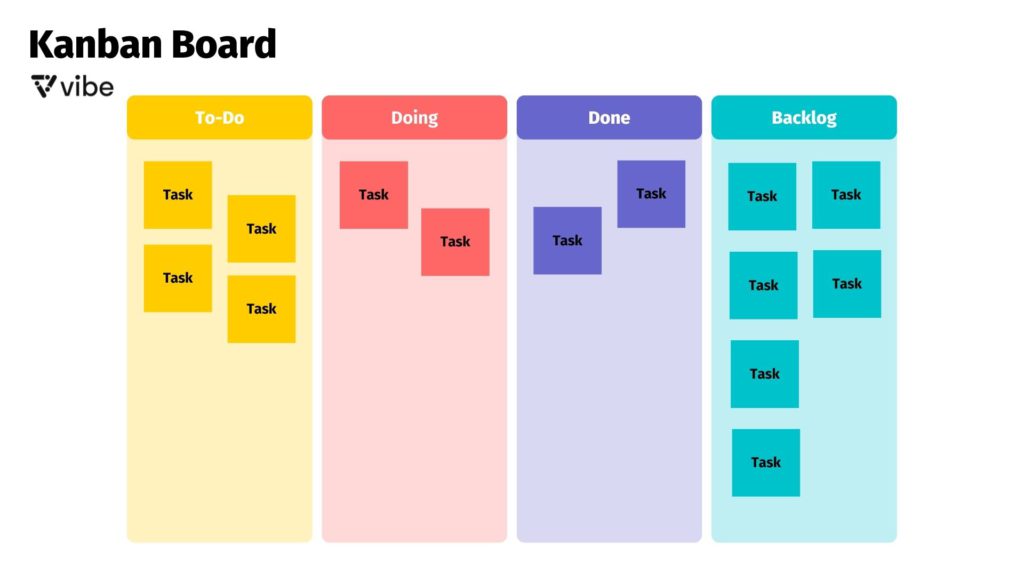If you’re familiar with agile methodology and sprint planning, you’ve probably come across two project management techniques: Kanban Boards and Scrum Boards.
Kanban and Scrum Boards are similar, but how do you choose the right one for your business and team? And how can you train your employees to utilize it to its full potential? Let’s examine the similarities and differences between the two methods so that you can decide which is best for you and your team.
What Is a Scrum Board?

Scrum Boards are a kind of visual tool that teams use to keep tabs on their progress and break down large projects into smaller, more bite-sized tasks. Scrum Boards are used to keep track of work across short periods of time, so they have a beginning and ending date. This time period is called a "sprint," and it normally lasts between two to four weeks.
Scrums are centered around five values: courage, attention, dedication, respect, and transparency. It’s the responsibility of the team members, and especially the Scrum Master, to ensure that these guiding principles are being followed at all times.
The most basic example of a Scrum Board is the General Scrum Board, which consists of four columns: Story, Not Started, In Progress, and Done.
Benefits of a Scrum Board

So, what’s the use of a Scrum Board? Let’s see how it benefits a company:
Transparency
You can monitor the development of your Scrum project and see how everything’s going. The Scrum task board is visible to all members of the team, so you can use it to get a head start on fixing problems while staying transparent.
Boost Cooperation and Productivity in Your Team
Scrum Boards are used to facilitate communication and collaboration among team members. This tool helps highlight your team’s progress and analyze the debates surrounding different project categories. In addition to lists of completed activities, you can see the number of unfinished tasks and encourage your team to finish them together.
Easy to Set Up
Using a digital scrum Board requires little technical know-how and can be set up in minutes. The standard Scrum tools and intuitive UI make it simple and quick to deploy Agile methods.
Recognize Root Causes Easily
Working on a Scrum project with several tasks assigned to multiple Scrum teams might be challenging, but a digital Scrum Board makes it easy to keep track of everything. It’s much easier to focus on what needs to be done upfront, and for everyone on the team to be on the same page.
What Is a Kanban Board?

A Kanban Board is a visual representation of a workflow. It’s one of the most well-known approaches to managing projects, and it’s useful for groups brainstorming and working in a wide range of industries.
With Kanban’s emphasis on visual management, teams often make use of visuals like boards to track the progress of tasks. It may be a physical board with sticky notes, or it could be an interactive whiteboard software with different categories.
A Kanban Board allows for the straightforward categorization of tasks into "to do," "in progress," and "done" columns.
Benefits of a Kanban Board

The Kanban Board is a useful resource for various reasons. Some of them are listed below.
Increases Visibility
The visual signals provided by a Kanban Board allow collaborators to easily monitor the development of a project. Due to this approach, teams can easily see how long a task takes, who’s working on it, and what they’re working on. It also facilitates the detection of roadblocks that may be stopping the team from working at peak efficiency.
Enhances Adaptability
Another major benefit of the Kanban Board is that it can overlap with existing workflows. With its easy configuration options, a Kanban Board allows teams to analyze the project and improve their workflow. It makes it easier to prioritize tasks and prevent any potential problems.
Prevents Bottlenecks
Implementing limits is essential to Kanban as it helps ensure teammates finish the task at hand before taking on additional work. Therefore, everything that is now being worked on must be finished and checked off in the "done" column before anything more can be done. This maintains a steady workflow for the team, allowing them to easily take up more tasks when they’re available.
Promotes Accountability
The board usually shows the status of deliverables, the tasks that depend on them, and when they should be finished. Keeping a visible record of your progress and accomplishments on a project is an excellent way to ensure that you’re taking responsibility for your work and keeping your team informed.
Choosing Between a Scrum Board & Kanban Board

Although we have addressed both methods separately, choosing between them depends on two common categories:
-
The team’s maturity
-
The tentative changes in a project
This implies that if your workforce is new to Agile or if the work required throughout a project is steady or planned, it would be easier to implement Scrum. However, if the team anticipates substantial changes or has reached an advanced stage of development that can optimize flow and fully benefit from continuous delivery, Kanban may be more appropriate.
To understand it better, let’s look at the similarities and differences between the two boards.
Similarities Between Scrum vs. Kanban Boards

Here are the following similarities between Scrum Boards vs. Kanban:
1. Both Follow Agile Methods
Both Kanban and Scrum are agile project management approaches that promote open communication and collaboration between team members, as well as shorter iterations of product development.
2. Both Have Similar Methodologies
Kanban utilizes a "pull system" where team members start new tasks only after finishing the tasks in the "In Progress" and "Completed" sections. As a result, it focuses on small but steady improvements.
Scrum also employs a "pull system," in which tasks are broken down into manageable chunks and completed in sprints.
The only difference between the two is that a Scrum sprint consists of several tasks, with an emphasis on delivering complete gains rather than incremental improvements.
3. Both Have Similar Software Tools
Both Scrum and Kanban Boards use similar software tools for their operation, which allow both team members to track their productivity, measure their success in real time, and get feedback from their stakeholders during the project cycle.
Differences Between Scrum vs. Kanban Boards

Here are the primary differences between the Kanban Board and the Scrum Board:
Work Scope
If your team is using a Kanban Board, you can see how they’re moving tasks forward in the project. The team members also move items from the "to-do" column to the "completed" section as needed.
The Scrum Board monitors and controls the individual tasks that make up a single sprint for a single Scrum team.
Timeline
Kanban never stops, and there’s no set limit on how many things any one team may be working on at once. As a flexible tool, the Kanban Board ensures that team members never have to go through several iterations of a task before it is completed.
The calendar on a Scrum Board is always the same. As the Scrum Board’s task is divided into two-week "sprints," it takes two weeks to complete.
Ownership
The Kanban Board is used by everyone in the company, regardless of their technical expertise. Therefore, it belongs to a specific department or the entire organization.
Since Scrum projects are always managed by the same group of individuals inside a company, a select group of people is responsible for updating and maintaining the Scrum Board.
Reports
Kanban is seldom used when it comes to the process of developing reports and graphs for the project. The primary purpose of the Kanban Board is to display the team’s workflow for the project’s development.
On the contrary, the Scrum task board data may be used to generate project reports and performance charts. This data is used to track how many tasks have been completed within a sprint cycle and how far along that cycle you currently are.
Using Vibe Interactive Whiteboard for Your Scrum & Kanban Boards

Deciding on whether a Scrum Board or a Kanban Board is suitable for your project depends on the needs of your team and tasks. Whatever you decide, creating your board with Vibe can help bring your teamwork to the next level. Vibe is an interactive whiteboard device that offers various Scrum and Kanban tools to help you create your board efficiently and share it effectively.
Along with collaborating in real-time, this smart whiteboard allows users to collaborate across devices in real-time, so you can keep projects on track and discuss methodologies and strategies, whether your team is in the same room or working across the globe.
FAQs
-
Are Kanban Boards better than Scrum Boards?
Neither approach is inherently superior to the other; rather, they thrive in somewhat different contexts. Kanban is a method for managing projects based on the idea of seeing the complete process from start to finish without keeping too many goals as "in progress." On the other hand, Scrum divides large projects into smaller chunks called "sprints."
-
How do you choose between Kanban and Scrum?
Kanban is useful for teams who want to see their products develop from start to finish, yet be able to pivot and adapt based on what feedback they get from clients. Scrum, on the other hand, is useful when the team wants to divide the project into smaller chunks and integrate feedback and modifications after each sprint is finished, rather than making adjustments as they go.








-1sbltxxq4FYxHrXrwJVLsCDNsXpqNa.webp)
-5Zp0pmSytvcuYDVs1LvuwplKuRneK0.webp)
